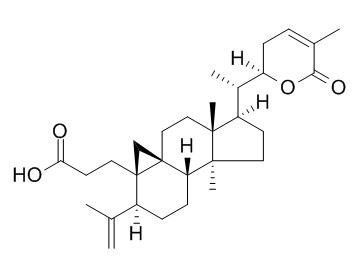Schisanlactone E
Schisanlactone E may show moderate cytotoxic activity against the human tumor cell lines Bel-7402, BGC-823, MCF-7 and HL-60.
Inquire / Order:
manager@chemfaces.com
Technical Inquiries:
service@chemfaces.com
Tel:
+86-27-84237783
Fax:
+86-27-84254680
Address:
1 Building, No. 83, CheCheng Rd., Wuhan Economic and Technological Development Zone, Wuhan, Hubei 430056, PRC
Providing storage is as stated on the product vial and the vial is kept tightly sealed, the product can be stored for up to
24 months(2-8C).
Wherever possible, you should prepare and use solutions on the same day. However, if you need to make up stock solutions in advance, we recommend that you store the solution as aliquots in tightly sealed vials at -20C. Generally, these will be useable for up to two weeks. Before use, and prior to opening the vial we recommend that you allow your product to equilibrate to room temperature for at least 1 hour.
Need more advice on solubility, usage and handling? Please email to: service@chemfaces.com
The packaging of the product may have turned upside down during transportation, resulting in the natural compounds adhering to the neck or cap of the vial. take the vial out of its packaging and gently shake to let the compounds fall to the bottom of the vial. for liquid products, centrifuge at 200-500 RPM to gather the liquid at the bottom of the vial. try to avoid loss or contamination during handling.
Biol Pharm Bull.2023, 46(2):245-256.
Plant J.2017, 90(3):535-546
Sustainability2021, 13(23),12981.
RSC Advances2017, 86
Cardiovasc Toxicol.2019, 19(4):297-305
Drug Chem Toxicol.2024, 1-10.
The Journal of Korean Medicine2023, 44(4):26-40.
Dermatologica Sinica2024, 42(1):p19-30.
J Cell Biochem.2022, 123(7):1222-1236.
Neuropharmacology.2018, 131:68-82
Related and Featured Products
Fitoterapia. 2014 Dec;99:352-61.
Bioactive metabolites of Schisanlactone E transformed by Cunninghamella blakesleana AS 3.970.[Pubmed:
25451796]
Schisanlactone E (SE) is a major triterpene obtained from the plants of genus Kadsura. The aim of this research was to investigate the transformed metabolites of Schisanlactone E by fungi and evaluate the bioactivities of these products.
METHODS AND RESULTS:
After screening 10 strains of filamentous fungi, Cunninghamella blakesleana AS 3.970 was chosen as a potent organism to be used for the biotransformation of Schisanlactone E. 13 metabolites were obtained and determined to be new compounds through the use of spectroscopic data, including UV, 1D-, 2D-NMR, and HR-ESIMS.
CONCLUSIONS:
Furthermore, in an in vitro bioassay, metabolites 7 and 9 showed moderate inhibitory effects on the nitric oxide production in LPS-induced macrophages with IC50 values of 16.73, 5.91 μM, respectively; 9 could inhibit the proliferation of acetaldehyde-induced HSC-T6 cells, with the IC50 value of 21.4 μM. Preliminary findings on the structure-activity relationships for these metabolites were also discussed.
Planta Med. 2006 Apr;72(5):450-7.
New triterpenoids from Kadsura heteroclita and their cytotoxic activity.[Pubmed:
16557460 ]
METHODS AND RESULTS:
Phytochemical investigations of the stem of Kadsura heteroclita (Roxb) Craib (Schizandraceae) resulted in the isolation and structure elucidation of six new triterpenoidal compounds named heteroclitalactones A-E (1-5) as well as heteroclic acid (6) and heteroclitalactone F (7), which was isolated for the first time from a natural source, and the six known compounds Schisanlactone E (8), cycloartenone (9), schisandronic acid (10), nigranoic acid (11), changnanic acid (12) and schisanlactone B (13), respectively. The structures of these compounds were characterized by extensive 1D and 2D NMR spectral analyses.
METHODS AND RESULTS:
The majority of these triterpenoids showed moderate cytotoxic activity against the human tumor cell lines Bel-7402, BGC-823, MCF-7 and HL-60. Among the compounds tested, heteroclitalactone D (4) showed the strongest cytotoxic activity against the HL-60 cells with an IC50 of 6.76 microM.



